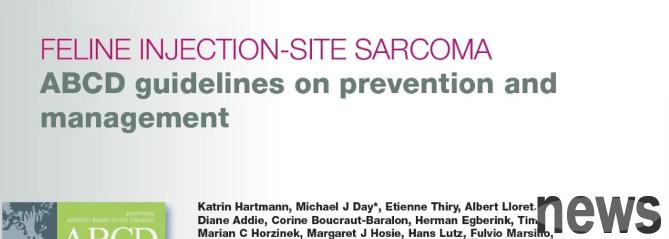Should cats be vaccinated? (Sarcoma at the cat injection site is terrifying)
For cats, the most serious adverse reaction after vaccination is the occurrence of aggressive sarcoma (mainly fibrosarcoma): the so-called "cat injection site sarcoma" (FISSs). These lesions occur at sites where they were previously vaccinated or injected. It has characteristics that are different from fibrosarcoma in other areas and exhibits stronger invasiveness. The transfer rate is 10-28%.
The pathogenesis of these sarcomas has not been clearly explained. However, chronic inflammatory responses are considered to be the cause of subsequent malignant transformation.

Injection of long-acting drugs (such as glucocorticoids, etc.) is related to sarcoma formation.
Vaccine with adjuvant can induce strong local inflammation and therefore appears to be closely related to the occurrence of FISSs.
Live-modified and recombinant vaccines have lower risks, but no vaccine is risk-free.
In addition to vaccines, injections such as long-acting glucocorticoids, penicillin, clofennulon, cisplatin and meloxicam are also related to sarcoma formation. One study found that the injection frequency of long-acting glucocorticoids (dexamethasone, methylprednisolone and triamcinolone) in interscapular FISSs cats was significantly higher than that in control cats. There are also reports of fibrosarcoma at the deep non-absorbable sutures in one cat; around the abdominal surgical swab of one cat; near the implantation site of the chip in two cats; and related to indwelling needles. This suggests that, theoretically, all inflammatory responses have the potential to trigger uncontrolled proliferation of fibroblasts and myofibroblasts, leading to the occurrence of FISSs, which in some cases may lead to malignant transformation.
Management
To avoid tumor recurrence, active radical resection is required. Added radiotherapy and/or immunotherapy (such as recombinant cat IL-2) can improve prognosis.
For prevention, any irritating substances should be avoided. Vaccination should be frequently received when necessary, but the less, the better.
The injection site should be selected where the surgery may be completely cured; try to avoid the scapular area. Monitoring should be carried out after immunization.
Where is the location for cats to get vaccinated? The American Association of Feline Physicians (AAFP) feline vaccination advisory group conducted an informal survey of veterinarians working in radiation (12), surgery (36), and internal medicine (44) oncology to seek their opinions on preferred vaccination sites. These experts agree that first the distal end of the knee joint, followed by second the distal end of the elbow joint is their preferred site. The tail is also a very popular injection site. Respondents often comment that vaccines should be administered as low as possible on the leg. The Vaccination Guidelines Group (VGG) of the World Small Animal Veterinary Association has made alternative recommendations, which recognizes the practical difficulties that veterinarians often face when trying to vaccinate on their limbs or tails. VGG's recommendation is that the preferred site for vaccination (and possible surgical removal of FISSs) is the skin on the side abdomen. This is a well tolerated surgery for most cats.
As a general recommendation, it is important to record the injection site in the patient's medical record. In addition, post-vaccination monitoring plays a crucial role in post-vaccination monitoring (3-2-1 principle) How much does it mean to know? 3 months after vaccination, any lump at the injection site still exists, with a diameter greater than 2 cm, or the lump is enlarged one month after vaccination and should be surgically removed.
So should cats get vaccinated? What rules should be followed?
01
Science Technology
Adult animals should use long vaccination intervals; it is recommended to use enhanced vaccines with a validity period of 3 or even 4 years (such as rabies vaccines and FPV vaccines).
Science Technology
Do not vaccinate FeLV or rabies for cats that are only active indoors;
Do not vaccinate for cats with antibodies. Vaccination in
02
cats provides the necessary protection and should not be stopped due to the risk of cat injection site sarcoma (FISSs). The
03
vaccine is not the only medical product injected with FISSs.
04
It is important to develop an individual vaccination plan. According to current guidelines, cats should be regularly checked for antibodies and get vaccinated if necessary.
Principle
1. Subcutaneous injection should be performed, rather than intramuscular injection.
2. Adjuvant-free vaccines should be given priority; live-modified or recombinant vaccines should be better than inactivated vaccines; long-term immunization vaccines should be given priority.
3. Cold vaccines are associated with higher risk of FISSs, so they should be kept at room temperature for 15 minutes before vaccination. But it should not be left in refrigerated conditions for several hours.




